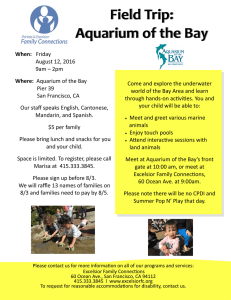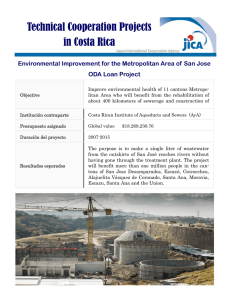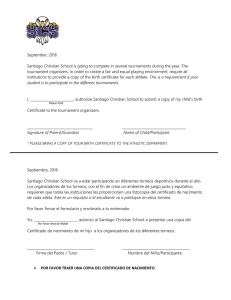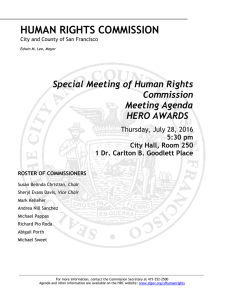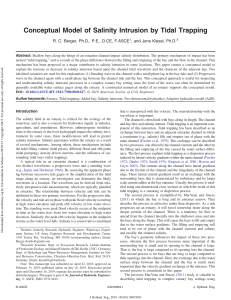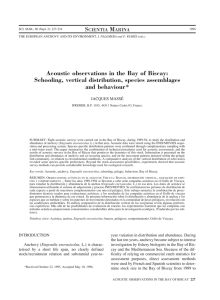the bay of san francisco. - American Antiquarian Society
Anuncio
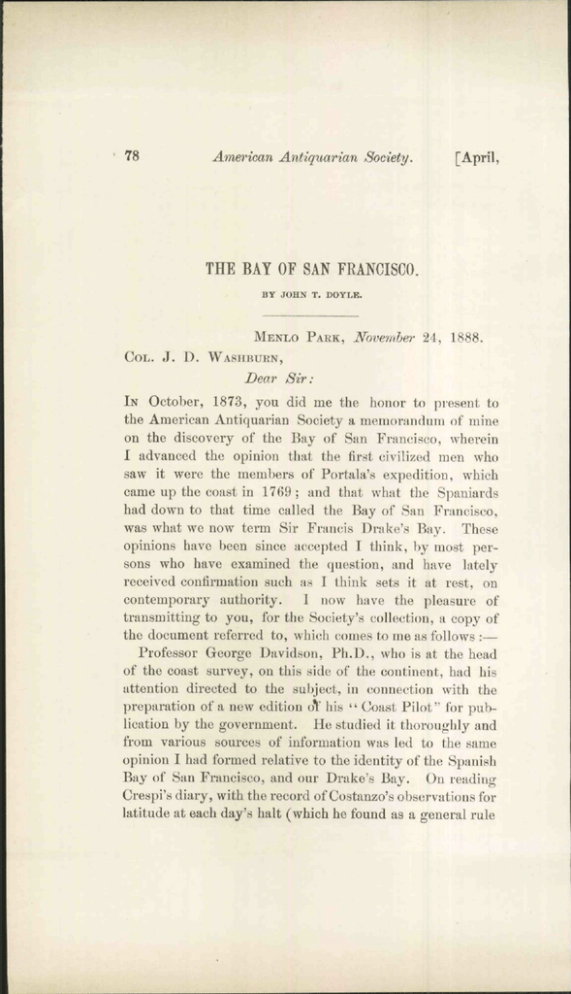
78 American Antiquarian Society. [April, THE BAY OF SAN FRANCISCO. BY JOHN T. DOYLE. MENLO PAKK, November 24, 1888. COL. J . D . WASIIBUKN, Dear Sir: IN October, 1873, you did me the honor to present to the American Antiquarian Society a memorandum of mine on the discovery of the Bay of San Francisco, wherein I advanced the opinion that the first civilized men wlio saw it were the members of Portala's expedition, which came up tlie coast in 1769 ; and that what the Spaniards had down to that time called the Bay of San Francisco, was what we now term Sir Francis Drake's Bay. These opinions have been since accepted I think, by most persons who have examined the question, and have lately received confirmation such as I think sets it at rest, on contemporary authority. 1 now have the pleasure of transmitting to you, for the Society's collection, a copy of the document referred to, which conies to me as follows :— Professor George Davidson, Ph.D., who is at the head of the coast .survey, on this side of the continent, had his attention directed to the subject, in connection with the preparation of a new edition oV his " Coast Pilot" for publiciitioa l)y the government. He studied it thorouglily and from various source.s of information was led to the same opinion I had formed relative to the identity of the Spanish Bay of San Francisco, and our Drake's Bay. On reading Crespi's diary, with the record of Costanzo's observations for latitude at each day's halt (which he found as a general rule 1889.] The Bay of San Francisco. 7ÍÍ remarkably correct), a professional instinct at once told him that so careful and accurate an observer as Costanzo had not failed to leave a record of his own ; and that in all probability he had, on his return, made a map of the coast so far as his observations extended. Acting on this opinion Prof. Davidson set on foot enquiries for such a niiip, and was rewarded by the discovery that it had not only been prepared and furnished to the Spanish government, but had iictually been engraved and printed as early as 1771. It is entitled " CiU'ta reducida, del ocoano Asiático, o mar dol sur, que comprchendo la costa oriental y occidental <le la peninsula de la California, con el golfe de su denominación, antiguamente con cido por la de mar de Cortcz, y de las costas de la America ^optentrional, desde el isthmo, que une dicha peninsula con el continente hasta el rio de los reyes, y desde el rio Colorado, hasta el cabo de Corrientes. Compuesta del orden del Exmo. Señor Mar(]uis de Croix, Vivey, gobernador y capitán general de la nueva España, y de loa exereitos de S.M." Under the title is a note in which Costanzo, under date of Oct. 30, 1770, enumerates the materials ft-om which his chart is compiled, giving prominence to the observations of the commanders of the packet boats which had recently made voyages up the coast, and those of the missionaries, etc., and modestly placing last the information acquired by himself in his journeys by land and sea, and his observations made on the spot. It is as follows :— "Los materiales que han servido a la formación de esta carta son, en primer lugar, los diarios de los pilotos que han navigado en el mar del sur en los últimos viages bochos a la California, y al norte de ella, a los puertos de S. Diego y Monterey ; con est)ecialidad los de D. Vincent Vila, Piloto del uumo. de primeros de la real armada, y Commandante de los Paquetbotes de S.M. destinados a la expedición Maritima, (|[ue se dirigió a dichas puertos ; y los diarios de navigacion, del 'Paquctbote el S. Antonio'en su viage hecho en el presente ano de 1770, con el proprio so American Antiquarian Society. [April, objeto de dicha expedición, la quai ha tenido éxito tan feliz, que hal)iendo este mismo paquetbote el S. Antonio llegado de a 31 de Mayo de 1770 al puerto de Monterey y hechado ancoras en el proprio puei'to y fondeadero, donde 168 anos estubo surta líi Esíjuadni del General Sebastian Vizcaino, enbínda al descubrimiento de estas costas por el Conde de Monterey, do orden dt; Señor Filifw III, y habiendo también llogado por tierra el 23 del citado iues y ano la tropa destinada al nii.smo fin, se ha fundado en Monterey un Presidio y Misión con la advocación de S. Carlos, y se forman iguales estjiblccimientos on los fertiles paiscs por dondt! transito la gente do la expedición, sin al adámente en el pueilo de S. Francisco, ocupado ahora de nuevo por los nuestros. Han contribuido a la mismo algunos fragmentes manuscritos, de la costa interior y exterior de la California, hallados entre los papeles de susaiitiguos mi.sioiieros con explicaciones relativas al asunto y otros documentos, frani|ueudos por algunos parliculares, de orden do esto superior Gobierero consernicntes a la costa de señora; por últimos las noticias adquiridas por el autor en sus viages de Mar y Tierra rectifiados })or varias ol)servacioncs hechos en los lugares y terreno que ha corrido. '* Mexico y Octubre 30 de 1770 ^ Miguel Costanzo, longitud del meridiano de Teneriffe." This map Prof. Davidson had carefully ti-aeed, and, at my suggestion, he now presents a photograph of the tracing to the Society. On it you will observe, the **Puerto de San Fraucisco" is laid down as immediately contiguous to the "Punta de los Reytjs," and the sheet of water forming the bays of San Francisco, San Pablo and Suisun (popularly included in the general designation of the Bay of San Francisco), is delineated with considerable accuracy of outline, and designated as the " Estero de San Francisco:'* a name then for the first time introduced to the Spanish geography of this coast. Iu my memorándum of 1873 above referred to, it is stated that Fortala's expedition, keeping close to the ocean shore, advanced us far up tlie coast as Half Moon Bay, and designated the headland which shelters that roadstead from the 1H89.] The Bay of San Francisco. 81 north as "Point Guardian Angel." The author of Vol. XIJI. of Bancroft's History of the Pacific States, at pages 155 and 15G, expresses the opinion that the expedition reached what we now call Point San Pedro, giving his reasons. The difference is not important, but as accuracy is never objectionable, I may be permitted to point out here, that this map of Costanzo confirms my conjecture that Half Moon Bay was the northern limit of their explorations. You will observe that up to and including that point the coast line is traced on it with remarkable accuracy, the headland which shuts in Half Moon Bay on the north being perfectly recognizable by its outline and direction, but all to the northward of this is evidently "sketched in," and the accuracy of the outline gradually diminishes with the increasing distance. No notice is taken of Point San Pedro, three only of the Farallones are laid down, and when Point Reyes is reached, all claim to accuracy has disappeared. In fact the outline is just such us it would appear through our hazy autumnal atmosphere, to one looking down from the summit of the hills overlooking Half Moon Bay, which are at the point where I suppose the explorers to have ascended them, from 1000 to UOO feet high. The fact that the traditional " Puerto de San Francisco " of the Spanish voyagers wherein the San Augustin was wrecked in 1595, and which was visited by Vizcaino in 1603, and was for a century and a half thereafter lost sight of, was a diiîerent place from that known by the same name at the present day, explains and accounts for ¡ill the confusion referred to by the author of Bancroft's Vol. XHI., in his note, p. 157. When I first called public attention to Crespi's diary, in August, 1870, I was under the same erroneous impression as Dwinelle, Randolph, Oak and others, that the Spanish Bay of San Francisco and the present bay of that name were identical. It was only after carefully studying the various documents brought to light in Palou's Noticias, and some contained in our archives, that I was led to the opinion— 6 82 American Antiquarian Society. [April, now reduced to certainty—that they were different ; that what they called the "Puerto de San Francisco," was Drake's bay, and that the present bay of San Francisco was absolutely unknown to them until discovered by Portala's expedition in October, 1709. The author of Bancroft's Vol. XIII., says at p. 157 : "There has been much perplexity in the minds of modern writers respecting the Port of San Francisco, resulting from want of familiarity with the original records, and the later transfer of the name to another bay. These writers have ftiiled to clear away the difficulties that seemed to surround the subject." In a note he adds, " Cei-tain exceptions should be noted. My assistant, in the Overland Monthly^ made known for the first lime to the Engîi>ih reading pitblicy the statements of Cabrera Bueno and Crespi, and in a few brief notes put the subject in its true light. Doyle, in notes to his reprint of Palou, subsequently gave a correct version and several writers since have partially utilized the information thus presented." This statement, so far as it relates to Cabrera Bueno's book, may pass as true ; but so far as regards Crespi's diary, it is (I regret, for the honor of our Pacific Coast " historian " to say it) quite the reverse. I called the attention of English speaking people, iocluding Mr. Bancroft and the members of the " History Company," to Crespi's diary, and ((uoted its statements as to the discovei'y of this bay of San Francisco, in August, 1870, in a public address delivered at the commencement of Santa Clara college, which was printed and circulated at the time. A copy was sent to Mr. Bancroft, and is referred to in his Vol. XIII., at pp. 141 and 150. Again in October, 1873, it was referred to in the "Memorandum" read by you before our Society, printed in its publislied proceedings, and thus laid before the English reading public. Mr. Bancroft having from the former of these sources learned the existence of Crespi's diary, and having thereafter procured a copy of the work 1880.] The Bay of San Francisco. 83 containing it, his assistant, Mr. H. L. Oak, published an account of it and of Cabrera Bueno's book, in the Overland Monthly t'ov June, 1874, eight months after the publication of this Society's proceedings al)ove referred to. TIUÎSC are the facts, as shown by the printed publications in their order. A writer of history should be truthful and accurate about matters resting in his own knowledge, else confidence can not be placed in his compilations. May I trouble you so much as to be the medium of prcííonting Prof. David.son's gift to the Society, and laying this note before them? I am, dear sir. Yours, very respectfully, JOHN T. DOYLE. Copyright of Proceedings of the American Antiquarian Society is the property of American Antiquarian Society and its content may not be copied or emailed to multiple sites or posted to a listserv without the copyright holder's express written permission. However, users may print, download, or email articles for individual use.
